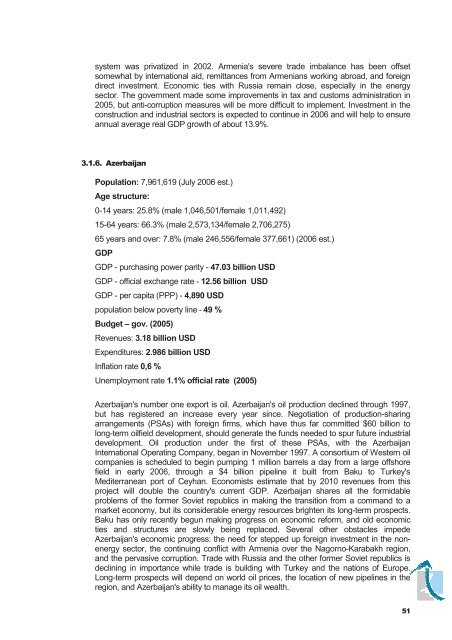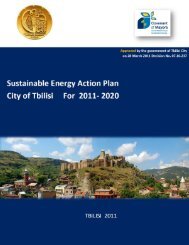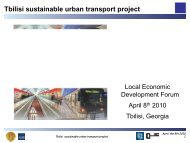LOCAL ECONOMIC DEVELOPMENT PLAN FOR TBILISI ... - LED
LOCAL ECONOMIC DEVELOPMENT PLAN FOR TBILISI ... - LED
LOCAL ECONOMIC DEVELOPMENT PLAN FOR TBILISI ... - LED
Create successful ePaper yourself
Turn your PDF publications into a flip-book with our unique Google optimized e-Paper software.
system was privatized in 2002. Armenia's severe trade imbalance has been offset<br />
somewhat by international aid, remittances from Armenians working abroad, and foreign<br />
direct investment. Economic ties with Russia remain close, especially in the energy<br />
sector. The government made some improvements in tax and customs administration in<br />
2005, but anti-corruption measures will be more difficult to implement. Investment in the<br />
construction and industrial sectors is expected to continue in 2006 and will help to ensure<br />
annual average real GDP growth of about 13.9%.<br />
<br />
Population: 7,961,619 (July 2006 est.)<br />
Age structure:<br />
0-14 years: 25.8% (male 1,046,501/female 1,011,492)<br />
15-64 years: 66.3% (male 2,573,134/female 2,706,275)<br />
65 years and over: 7.8% (male 246,556/female 377,661) (2006 est.)<br />
GDP<br />
GDP - purchasing power parity - 47.03 billion USD<br />
GDP - official exchange rate - 12.56 billion USD<br />
GDP - per capita (PPP) - 4,890 USD<br />
population below poverty line - 49 %<br />
Budget – gov. (2005)<br />
Revenues: 3.18 billion USD<br />
Expenditures: 2.986 billion USD<br />
Inflation rate 0,6 %<br />
Unemployment rate 1.1% official rate (2005)<br />
Azerbaijan's number one export is oil. Azerbaijan's oil production declined through 1997,<br />
but has registered an increase every year since. Negotiation of production-sharing<br />
arrangements (PSAs) with foreign firms, which have thus far committed $60 billion to<br />
long-term oilfield development, should generate the funds needed to spur future industrial<br />
development. Oil production under the first of these PSAs, with the Azerbaijan<br />
International Operating Company, began in November 1997. A consortium of Western oil<br />
companies is scheduled to begin pumping 1 million barrels a day from a large offshore<br />
field in early 2006, through a $4 billion pipeline it built from Baku to Turkey's<br />
Mediterranean port of Ceyhan. Economists estimate that by 2010 revenues from this<br />
project will double the country's current GDP. Azerbaijan shares all the formidable<br />
problems of the former Soviet republics in making the transition from a command to a<br />
market economy, but its considerable energy resources brighten its long-term prospects.<br />
Baku has only recently begun making progress on economic reform, and old economic<br />
ties and structures are slowly being replaced. Several other obstacles impede<br />
Azerbaijan's economic progress: the need for stepped up foreign investment in the nonenergy<br />
sector, the continuing conflict with Armenia over the Nagorno-Karabakh region,<br />
and the pervasive corruption. Trade with Russia and the other former Soviet republics is<br />
declining in importance while trade is building with Turkey and the nations of Europe.<br />
Long-term prospects will depend on world oil prices, the location of new pipelines in the<br />
region, and Azerbaijan's ability to manage its oil wealth.
















